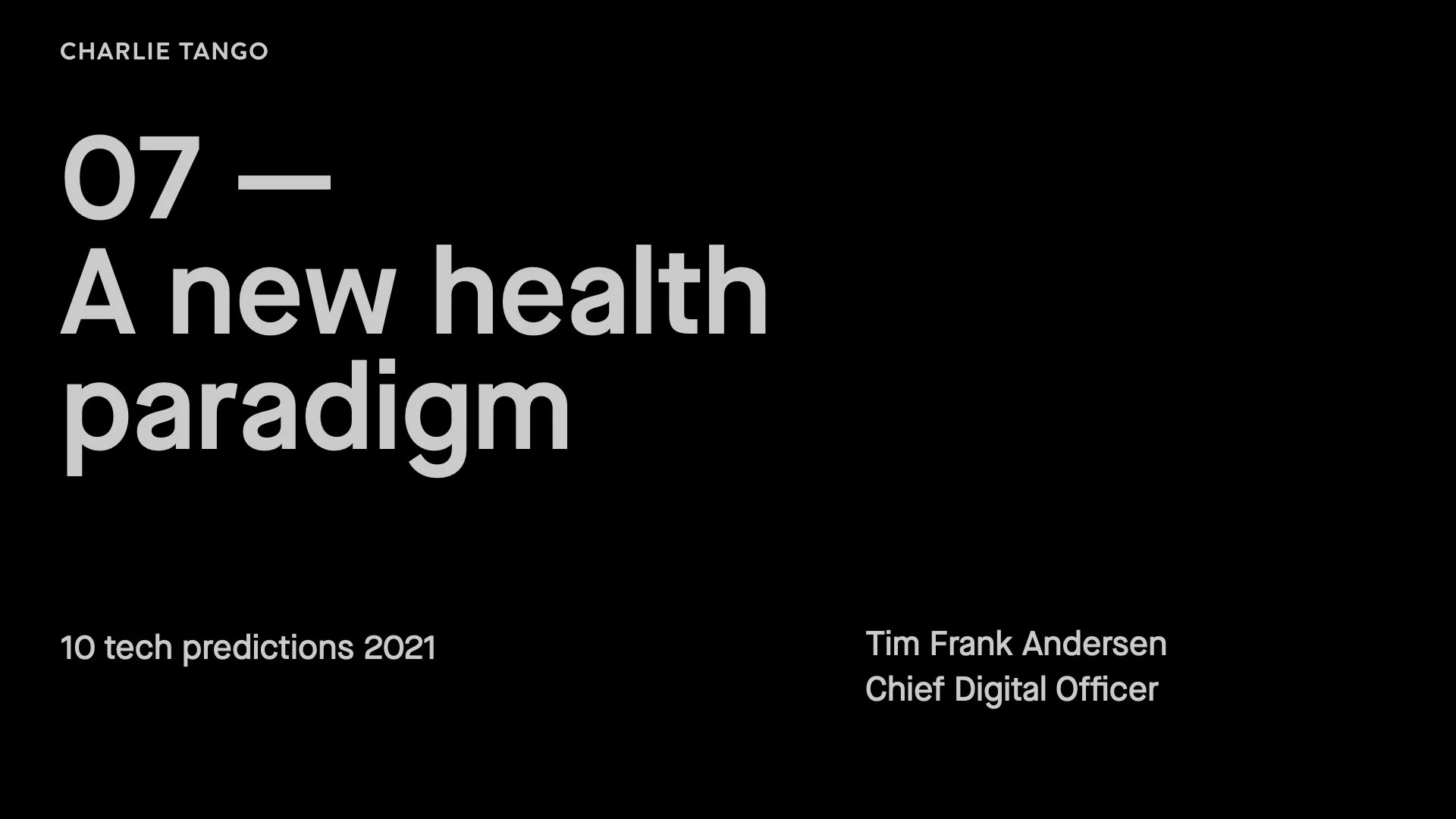A new health paradigm
“Going to the doctor” is taking on a whole new meaning these days, indicating that we are entering a totally new health paradigm.
Consumer electronics with new tracking and surveillance possibilities, breakthroughs in the usage of AI for early detection and diagnosis, and personalized medicine & genetics are all technologies supporting the shift to a data-driven home-care and self-care model that will dominate the healthcare and health insurance industry going forward.
We are on the edge of a new paradigm, changing a lot of areas within Healthcare
But let´s start by visiting the doctor in a 2021 setting:
The doctor will see you now — through the screen
Telehealth or telemedicine has for a long time been a thing of the future, but all that is changing as we speak. The pandemic has just speeded up its arrival significantly all around the world.
Ping An Good Doctor (PAGD) — a healthcare service platform backed by the largest insurance company in the world — provides an end-to-end service for patients, including 24/7 online consultations, prescriptions, referrals, second medical opinions and drug deliveries — all taking place in pop-up one-minute-clinics at street level.
The Ping An pop-up one-minute-clinic
Their proprietary artificial intelligence (AI)-based medical system allows in-house full-time medical doctors and physicians to treat 600–700 patients daily. Try telling that to a Danish practitioner! In the first half of 2020, PAGD saw an average of 831,000 medical consultations daily — nine times more than the year before.
Several other similar platforms exist in China, like Tencent Trusted Doctors (TTD), all of them experiencing explosive growth and accelerating demand for telemedicine solutions that doesn´t seem to slow down.
One-stop AI based Diagnosis at TenCent Trusted Doctors
Next year, PAGD is planning to launch Ping An Doctor Home, taking the service into the living room.
Same situation in the US
The US is experiencing the same need for a change. New primary care subscription services deliver in-person video consultations, 24/7 on-demand video chat and app-based Rx renewals. One Medical, a company backed by Alphabet, is a good example. Right now, they deliver virtual digital care to more than 500.000 members.
One Medicals 1Life Health platform
But One Medical also provides physical clinics with a much nicer feel than the public healthcare alternative.
Virtual telehealth in new areas
Virtual telehealth solutions are also moving into other areas:
Colgate has recently launched Dentists For Me, a teledentistry platform connecting people across India with over 150 dentists. This is available as an app or a web version.
Colgate has launched a virtual dentist platform in India
UK-based Superdrug partnered with My Online Therapy to offer mental health services to customers. Filling out a questionnaire enables you to schedule appointments with a range of different qualified specialists. Prices start at 400 DKK for a 30-minute virtual counseling session.
Whether it’s the ability to save travel time or waiting time, the comfort of talking to a physician from one’s own home, the convenience of consulting with a practitioner at any time of day, or the reassurance that you can avoid becoming infected at the doctor’s or at the hospital, telemedicine offers significant advantages over traditional brick-and-mortar healthcare. And according to Deloitte, 86% of Gen Z consumers and 88% of those with chronic conditions who have tried virtual care would choose it again.
On the technology side, we see our wearables like smartphones, smartwatches, rings and Fitbits becoming health tech tools in themselves, monitoring our well-being in real-time. The data they provide opens up an opportunity for continuous health tracking and home care.
The newest version of the Apple Watch Series 6 measures your ECG, oxygen blood level, heart rate and sleep pattern and detects if you fall, sending out automatic alerts and calling 911 if you set it up.
The newest Apple iWatch is filled with sensors
The Samsung Galaxy 3 Watch tops that, offering blood pressure measurement as well
Huawei´s newest smartphone even has an integrated infrared sensor capable of measuring your temperature by placing the phone directly on your forehead.
In 2021, Fitbit will introduce continuous heart rhythm assessments through a technology known as PPG (photoplethysmography). This will give you a better sense of your heart health, offering early warning signs for heart problems.
Smart Textiles
All this is possible through the development of microsensors. And soon these sensors will be moving into our clothes. Smart textiles have been under development for many years but are now ready for a breakthrough in the health area. Two great examples are Hexoskin and Nuubo.
Hexoskin integrates micro sensors directly into he clothes
The company Healthy.io is moving in a different direction by turning the smartphone camera into a medical device with app-based home testing solutions for the early detection of chronic kidney disease, urinary tract infections and digital wound management.
Cue Health is releasing a device for Home Testing
Home testing is also the goal for the US company Cue Health, which is working on a small device that’s able to perform a multitude of tests, with Covid-19 obviously being one of the first.
Cue Health is beta testing Covid-19 tests in 5 states
The product has been released in five states. It may not be ready for in-home testing yet, but that’s set to happen in 2021.
One Danish competitor to Cue Health is Q-Life, which also plans to bring a test device into our homes, like a Nespresso machine for home tests.
A lot is happening in the healthcare arena, which is why I refer to it as a new health paradigm. The current pandemic has forced the development dramatically forward, but 2021 will be the year where we see real changes starting to happen.











